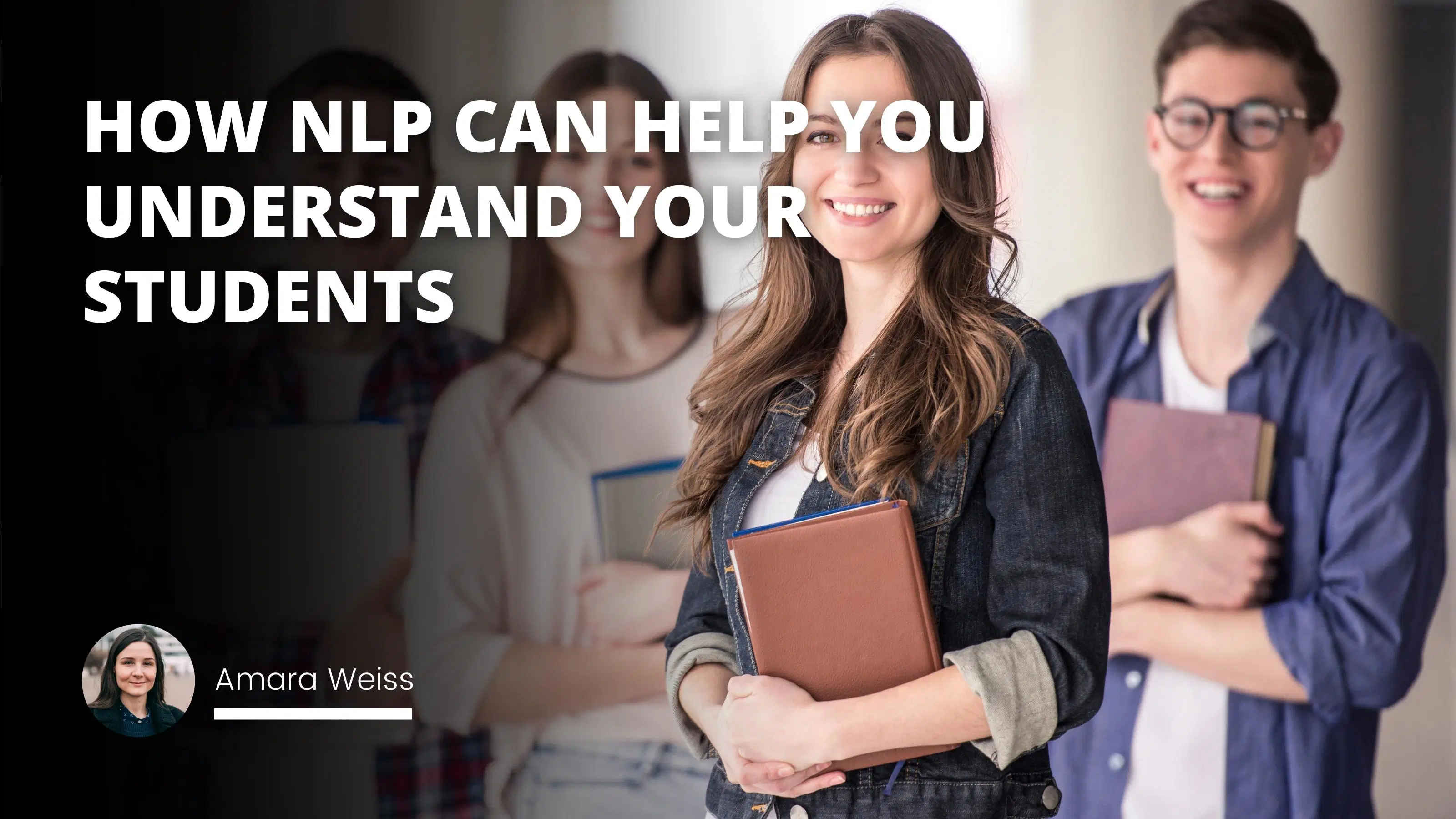
Natural Language Processing (NLP) has emerged as a powerful tool in the field of education, offering institutions valuable insights into their students' needs, preferences, and behaviors. By analyzing vast amounts of text data, such as student writing samples, feedback, and social media activity, NLP can help educators better understand their students and tailor their teaching approaches accordingly. As a college professor with over a decade of experience, I have witnessed firsthand the transformative potential of NLP in the classroom.
One of the most significant benefits of NLP in higher education is its ability to identify at-risk students early on. By analyzing student writing samples and class participation, NLP algorithms can detect patterns that may indicate a student is struggling academically or emotionally. For example, a sudden drop in the quality of a student's writing or a decrease in class attendance may signal that the student is experiencing personal difficulties or falling behind in their coursework. By identifying these issues early, institutions can intervene and provide targeted support to help the student get back on track.
NLP can also be used to analyze student feedback, providing valuable insights into students' thoughts and opinions about their educational experience. By processing course evaluations, surveys, and other forms of student feedback, NLP can identify common themes and sentiments, allowing institutions to make data-driven decisions about curriculum development, teaching methods, and student services. For instance, if NLP analysis reveals that a significant number of students are struggling with a particular course or find the material too challenging, the institution can take steps to revise the curriculum or provide additional support resources.
Another promising application of NLP in education is sentiment analysis. By analyzing the emotional tone of student writing and feedback, NLP can provide insights into students' attitudes and feelings about their learning experience. This information can be particularly valuable for identifying students who may be at risk of dropping out or disengaging from their studies. For example, if NLP sentiment analysis reveals that a student consistently expresses frustration or dissatisfaction with their coursework, the institution can reach out to the student and offer support or guidance to help them overcome their challenges.
Monitoring student social media activity is another area where NLP can provide valuable insights. By analyzing posts and comments on platforms like Twitter, Facebook, and Instagram, institutions can gain a better understanding of students' interests, concerns, and social dynamics. This information can be used to inform student services, extracurricular activities, and campus events. For example, if NLP analysis reveals that a significant number of students are discussing mental health issues on social media, the institution can take steps to provide additional counseling services or awareness campaigns.
In addition to these applications, NLP can also be used to automate essay scoring and provide personalized feedback to students. By training NLP algorithms on large datasets of student writing, institutions can develop automated grading systems that can provide rapid and consistent feedback on student assignments. This can be particularly valuable in large classes where providing detailed feedback to each student can be time-consuming and challenging. Additionally, NLP can be used to provide personalized writing prompts and exercises based on a student's individual strengths and weaknesses, helping them to develop their writing skills more effectively.
Despite the many benefits of NLP in education, it is important to recognize that it is just one tool in the educator's toolkit. To fully understand students' needs and experiences, institutions must use a variety of methods, including surveys, focus groups, and one-on-one conversations. By combining NLP with traditional research methods, institutions can gain a more comprehensive understanding of their students and develop more effective strategies for supporting their success.
One example of how NLP can be combined with other research methods is through the use of student surveys. By analyzing survey responses using NLP techniques, institutions can identify common themes and sentiments that may not be immediately apparent from a cursory review of the data. For instance, NLP analysis may reveal that students who report high levels of stress also tend to express dissatisfaction with certain aspects of their coursework or campus life. By combining this information with demographic data and academic performance metrics, institutions can develop targeted interventions to support these students and improve their overall experience.
Another promising application of NLP in education is personalized learning and advising. By analyzing student data from a variety of sources, including writing samples, course performance, and extracurricular activities, NLP algorithms can provide personalized recommendations for courses, majors, and career paths. For example, if NLP analysis reveals that a student has a strong interest in environmental science and has performed well in related courses, the algorithm may recommend that the student consider pursuing a degree in environmental studies or a career in sustainability. By providing students with personalized guidance and support, institutions can help them make informed decisions about their academic and professional futures.
Successful NLP case studies in schools provide further evidence of the transformative potential of this technology. For instance, Georgia State University used NLP to analyze student data and identify at-risk students who were in danger of dropping out. By providing these students with targeted support and interventions, the university was able to increase its graduation rates by 22 percentage points over a ten-year period (Kamenetz, 2016). Similarly, the University of Arizona used NLP to analyze student writing samples and provide personalized feedback to help students improve their writing skills. The results were impressive, with students who received NLP feedback showing significant improvements in their writing performance compared to a control group (McNamara et al., 2015).
While NLP offers many exciting possibilities for education, it is important to approach this technology with care and consideration. One potential concern is the issue of privacy and data security. As institutions collect and analyze vast amounts of student data, they must take steps to protect students' personal information and ensure that it is used ethically and responsibly. Additionally, there is a risk that NLP algorithms may perpetuate biases or disparities if they are trained on datasets that are not representative of the student population as a whole. To mitigate these risks, institutions must work closely with NLP experts and ethicists to develop rigorous data governance policies and ensure that algorithms are designed and implemented in a fair and equitable manner.
Another challenge of implementing NLP in education is the need for specialized expertise and resources. Developing and maintaining NLP algorithms requires significant investments in technology, personnel, and training. For smaller institutions with limited budgets, these costs may be prohibitive. However, as NLP becomes more widely adopted in education, there may be opportunities for institutions to collaborate and share resources to make this technology more accessible and affordable.
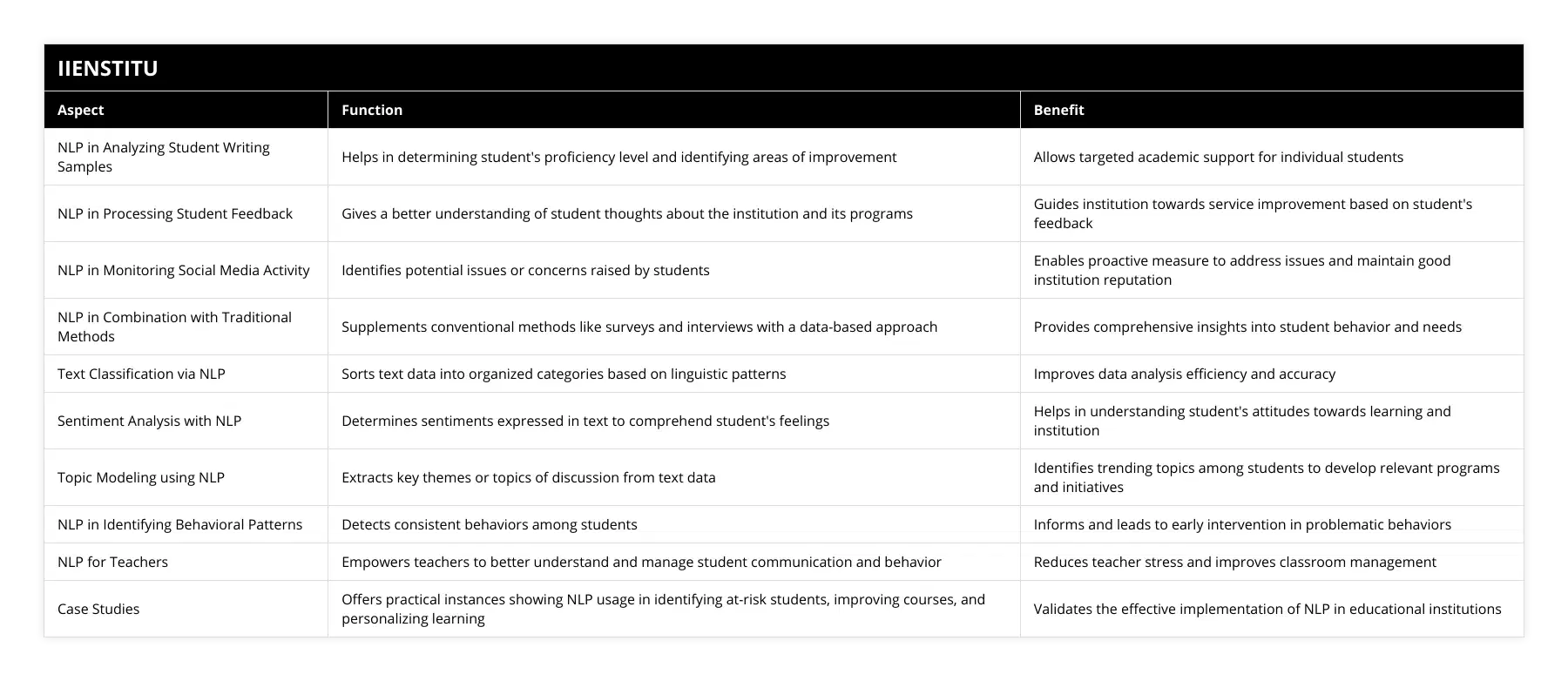
Despite these challenges, the potential benefits of NLP in education are too significant to ignore. By providing educators with powerful tools for understanding and supporting their students, NLP has the potential to transform the way we teach and learn. As an educator, I am excited to see how this technology will continue to evolve and shape the future of education.
References:
Kamenetz, A. (2016). The Test: Why Our Schools are Obsessed with Standardized Testing – But You Don't Have to Be. PublicAffairs.
McNamara, D. S., Crossley, S. A., Roscoe, R. D., Allen, L. K., & Dai, J. (2015). A hierarchical classification approach to automated essay scoring. Assessing Writing, 23, 35-59.
Meyer, B. J. F., Wijekumar, K., Middlemiss, W., Higley, K., Lei, P. W., Meier, C., & Spielvogel, J. (2010). Web-based tutoring of the structure strategy with or without elaborated feedback or choice for fifth- and seventh-grade readers. Reading Research Quarterly, 45(1), 62-92.
Frequently Asked Questions
How can institutions use NLP to understand their students better?
Institutions can use NLP to understand their students in various ways better. For example, NLP can be used to analyze student essays and generate feedback automatically. Additionally, NLP can monitor student activity on online learning platforms and look for patterns that may indicate difficulty understanding the material. By using NLP to understand their students better, institutions can more effectively tailor their instruction to meet the needs of their student body. In doing so, they can improve student outcomes and better prepare their students for success in the real world.
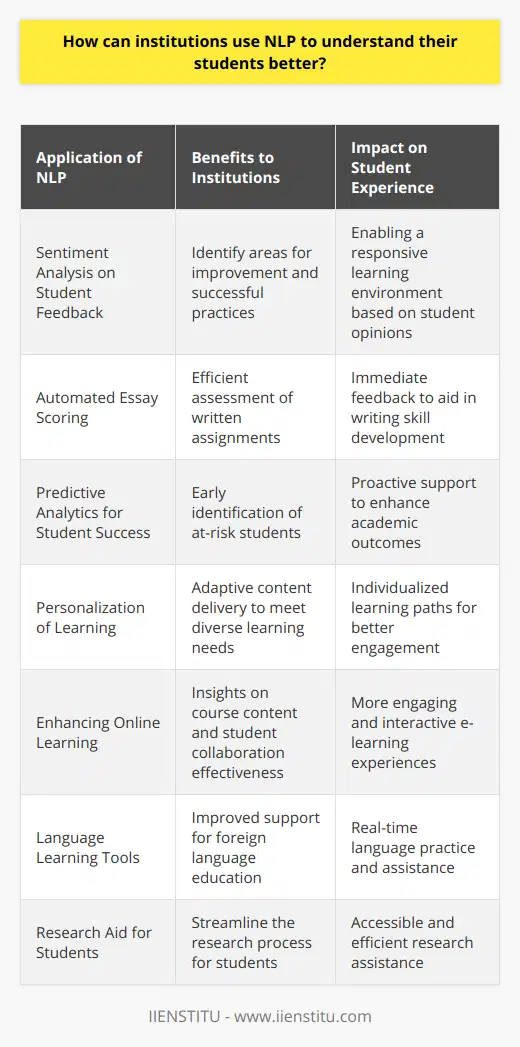
What are some benefits of using NLP to analyze student data?
When it comes to education, data is everything. From class performance to standardized test scores, every piece of information can be used to help improve the quality of instruction and better support students. However, sifting through all of that data can be a daunting task. That's where NLP comes in. Natural language processing is a form of artificial intelligence that helps computers understand human language. When applied to student data, NLP can automatically identify patterns and trends that would be difficult for humans to spot. As a result, NLP can be an invaluable tool for analysts and educators alike. In addition to making data easier to understand, NLP can also help save time and resources. By automating the data analysis process, NLP frees analysts to focus on more critical tasks. And because it doesn't require special hardware or software, it's also very cost-effective. So if you're looking for a way to make sense of all those student data, NLP is worth considering.

How accurate is NLP when it comes to an understanding a student's feelings or emotions?
NLP, or natural language processing, is a field of computer science that deals with interpreting and analyzing human language. In recent years, NLP has been used in various applications, including sentiment analysis and emotion recognition. But how accurate is NLP when it comes to an understanding a student's feelings or emotions?
To answer this question, let's first look at how NLP works. NLP algorithms are designed to "read" text and identify specific patterns or features. For sentiment analysis, for example, an NLP algorithm might be prepared to look for words typically associated with positive or negative emotions. Based on the number of positive and negative emotions found in a piece of text, the algorithm can then predict the overall sentiment of the text.
So, how accurate is NLP when it comes to an understanding a student's feelings or emotions? The answer depends on several factors, including the quality of the data being processed and the specific task the NLP algorithm is trying to accomplish. In general, however, NLP can be pretty accurate when understanding simple emotions like happiness or sadness. More complex emotions, such as anger or anxiety, are more difficult to detect and may require additional contextual information. Nevertheless, NLP provides a powerful tool for automatically analyzing and understanding student emotions.
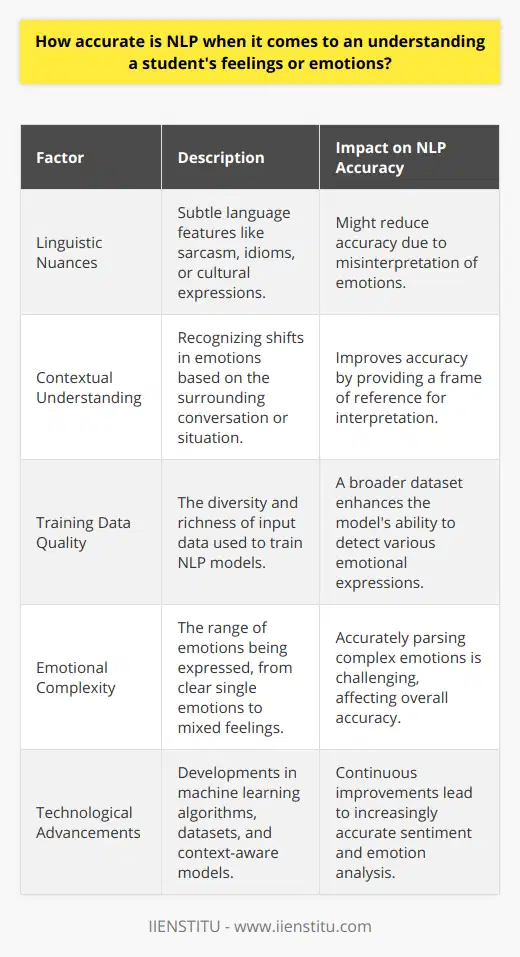
When using NLP to analyze student data, is there anything that institutions should be wary of?
As anyone who's ever had their data mishandled by a government institution knows, the risks of entrusting sensitive information to large organizations are manifold. But when it comes to using natural language processing (NLP) to analyze student data, there are some other things that institutions should be wary of. First and foremost among these is the potential for biased results. Because NLP relies on algorithms to process and interpret data, any inherent biases in those algorithms can be magnified in the results. In addition, NLP can also be fooled by "noise" in the data - false positives that can lead to incorrect conclusions. As such, institutions need to take care when using NLP to ensure that they are aware of these potential pitfalls.
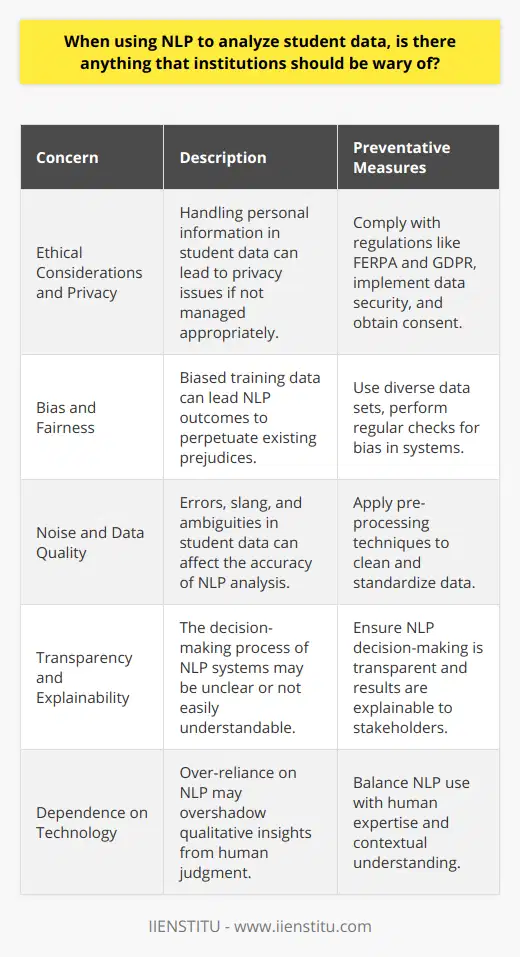
What kind of feedback have you received from institutions that have started using NLP?
We've received a lot of feedback from institutions that have begun using NLP, and it's been overwhelmingly positive. People are excited about the potential of NLP to help them with their work. We've heard from people in various fields, including education, healthcare, and business, who find value in NLP. One of the most common things we hear is that NLP is helping people to save time and be more productive. We also hear that NLP provides valuable insights that wouldn't have been possible with traditional methods. Overall, we're very encouraged by the feedback we've received from institutions using NLP.
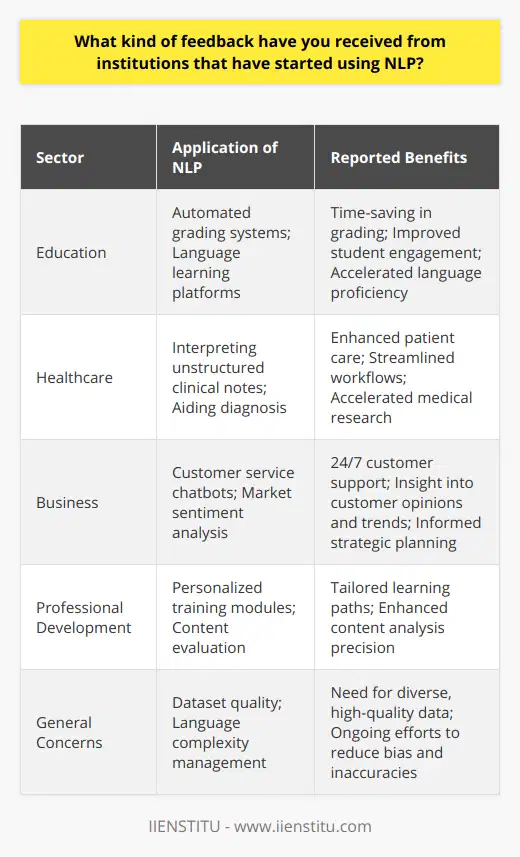
How do educational institutions use natural language processing?
Educational institutions have begun to use natural language processing (NLP) to process student essays and other written documents. Academic institutions can automate the grading process using NLP, saving time and money. NLP can also be used to provide feedback to students on their writing. For example, NLP can be used to identify common errors in grammar and style. In addition, NLP can be used to help identify plagiarism. Finally, using NLP, educational institutions can ensure that students receive fair and objective grades.
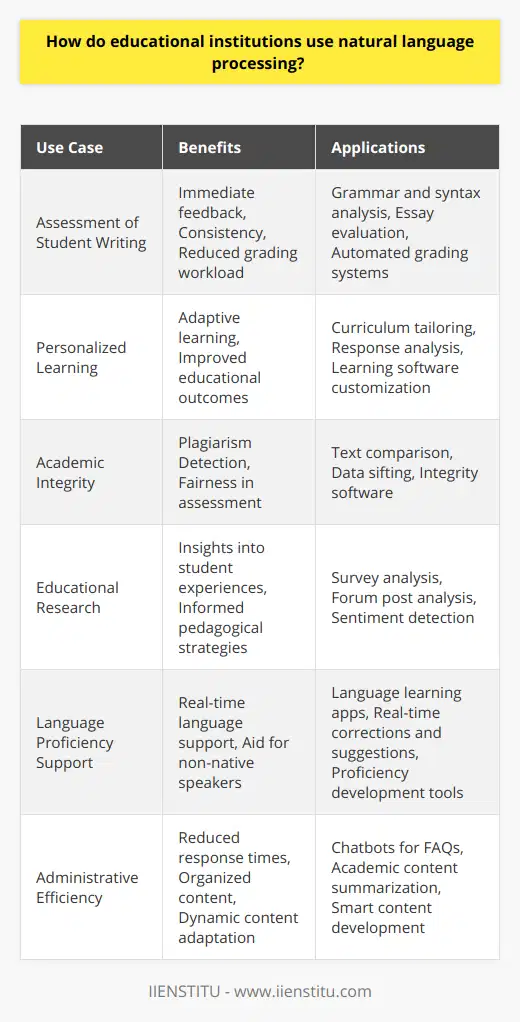
What are the benefits of using NLP for understanding students?
NLP, or neuro-linguistic programming, is a tool that can be used to help understand how people communicate. By understanding the patterns of language use, NLP can help identify the underlying meaning of what is being said. This can be particularly useful in educational settings, where NLP can be used to help understand how students are processing information. In addition, NLP can also be used to help identify learning difficulties and design interventions that target those difficulties. As a result, NLP is a valuable tool that can improve students' educational outcomes.
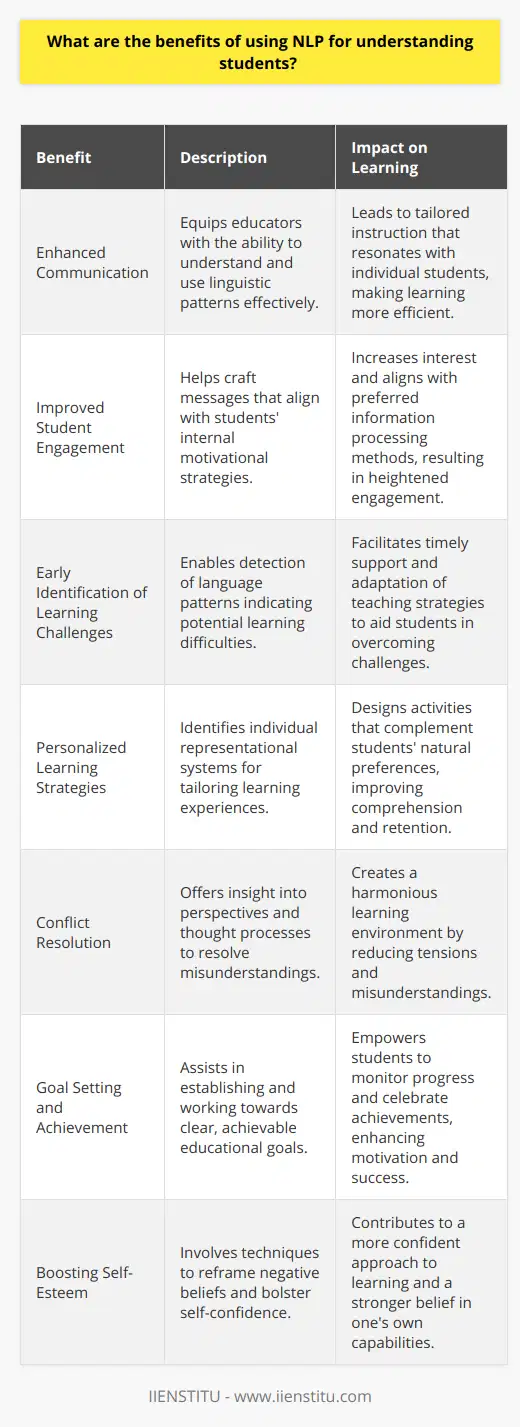
How does NLP help educators better understand their students?
As an educator, it's essential to understand your students. After all, how can you teach them effectively if you don't know how they learn? That's where NLP comes in. NLP, or Neuro-Linguistic Programming, is a therapy that helps people better understand their thoughts and behaviors. By understanding how their students think and learn, educators can adapt their teaching methods to suit each individual better. In other words, NLP can help educators fine-tune their processes and ensure that each student gets the most out of their education. And that's something we can all benefit from.
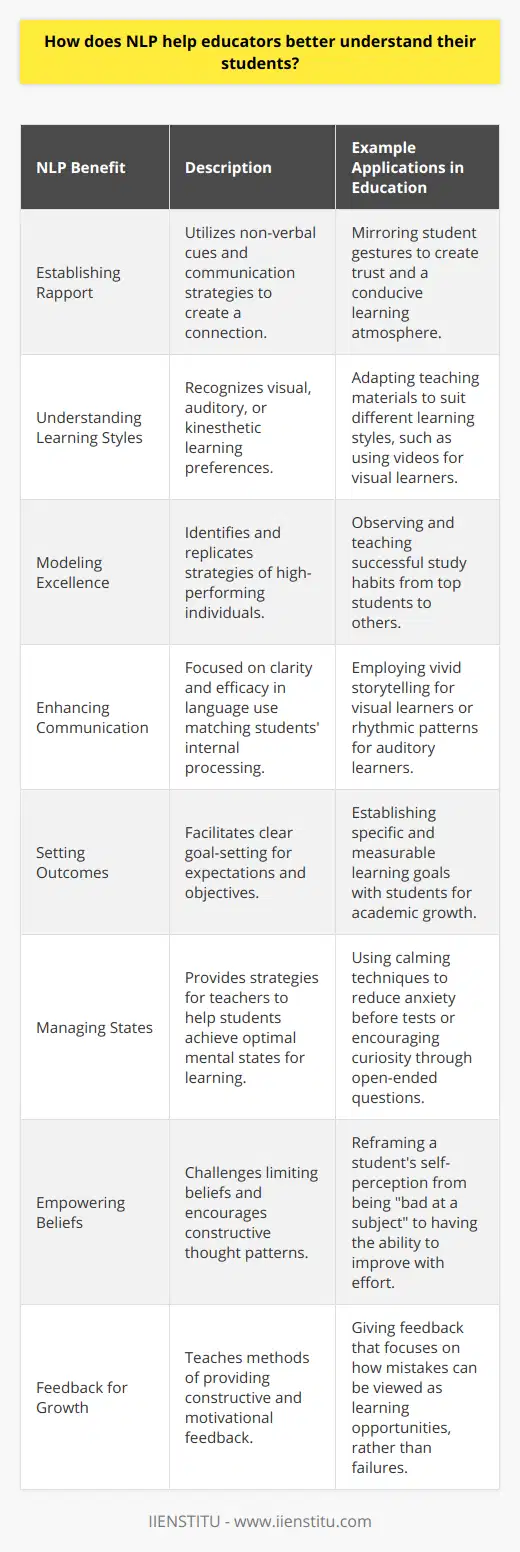
What sort of data is analyzed by NLP tools?
NLP, or natural language processing, is artificial intelligence that deals with understanding and manipulating human language. There are many ways to analyze data with NLP tools, but some of the most common methods include principle component analysis, topic modeling, and sentiment analysis. PCA is a statistical technique that can reduce the dimensionality of data, making it easier to work with. Topic modeling is a method of extracting topics from a text, and sentiment analysis is used to understand the emotions expressed in a text. These are just a few of the many ways that NLP tools can be used to analyze data.
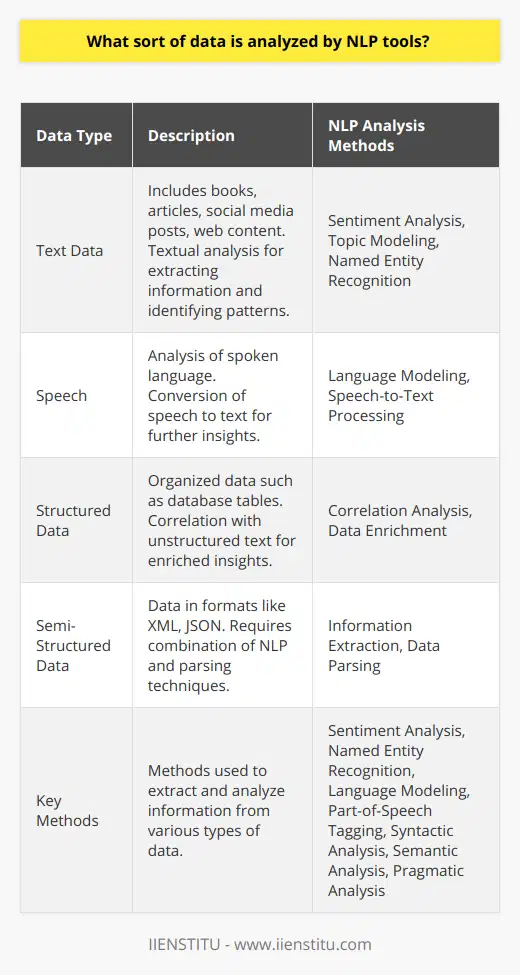
What are the advantages of neuro-linguistic programming in education?
Advantages of Neuro-Linguistic Programming in Education
Enhanced Learning Retention
One significant advantage of neuro-linguistic programming (NLP) in education is the improvement of learning retention rates. NLP techniques enable learners to process and recall information more effectively, leading to a deeper understanding and longer-lasting knowledge.
Effective Communication Skills
NLP aids educators in refining their communication skills, facilitating the ability to accurately convey complex ideas to students in a concise and comprehensible manner. The adoption of NLP techniques helps teachers become more aware of their language patterns and non-verbal cues, allowing for better interpretation and understanding of the conveyed information.
Promotion of Emotional Intelligence
NLP significantly contributes to the development of emotional intelligence in both teachers and students. It assists in understanding emotions, managing stress, and improving one's ability to cope with challenging situations. By developing emotional intelligence, individuals are better equipped to build strong relationships, handle conflicts, and communicate effectively, ultimately contributing to a healthy learning environment.
Personalized Learning Approaches
NLP allows for the design of personalized learning approaches for students, acknowledging that each individual has their unique ways of processing and understanding information. By identifying and adapting to different learning styles, educators can develop effective teaching strategies that cater to each student's needs, resulting in a higher level of engagement and academic success.
Enhancement of Self-Confidence
The implementation of NLP techniques in education fosters an increase in self-confidence among students. NLP encourages the development of a growth mindset and facilitates the setting of achievable goals. As students become more confident in their abilities, they are more likely to become accomplished lifelong learners.
In conclusion, neuro-linguistic programming offers numerous advantages in the education sector, including improved learning retention, effective communication skills, promotion of emotional intelligence, personalized learning approaches, and enhanced self-confidence. These benefits, combined with a focused effort to integrate NLP into educational practices, have the potential to significantly impact students' learning experiences and outcomes.
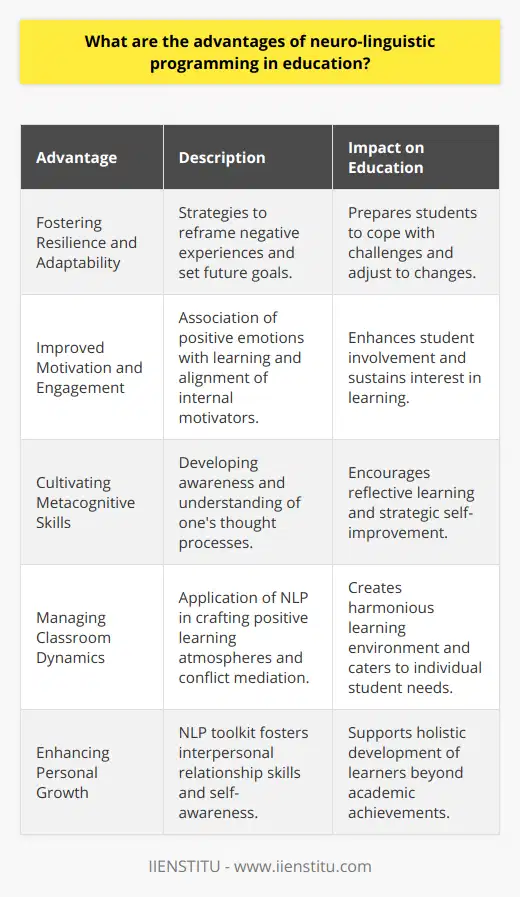
What is the role of neurolinguistics in teaching and learning?
The field of neurolinguistics studies brain and language interactions, providing valuable insights for teaching and learning. In this context, neurolinguistics plays three major roles: enhancing pedagogical approaches, informing assessment methods, and supporting language acquisition.
Enhancing Pedagogical Approaches
Neurolinguistic research informs evidence-based teaching methods that capitalize on brain function and cognitive processes. For instance, studies have shown that the brain processes information in chunks, which has informed teaching strategies wherein information is broken down into manageable segments. Furthermore, understanding language processing can help educators devise techniques for encouraging active processing, leading to more effective learning.
Informing Assessment Methods
The assessment of language skills is crucial for both teachers and students, offering valuable feedback regarding progress and difficulties. Neurolinguistics offers a scientific foundation for understanding how language skills are developed and how different factors, such as age, cognitive abilities, or socio-cultural variables, can impact this development. This knowledge allows for the creation of valid and reliable assessment tools that can inform language instruction and help identify potential learning difficulties in students.
Supporting Language Acquisition
Neurolinguistics enhances our understanding of the process of language acquisition, unveiling the underlying mechanisms that drive this complex phenomenon. By examining the brain's response to linguistic stimuli and exploring the role of memory, attention, and neural connectivity, educators can develop teaching methods aimed at facilitating language acquisition. Moreover, these insights inform the most effective approaches for teaching specific aspects of language, such as vocabulary, grammar, or pronunciation, and can also guide interventions for individuals with language-related disorders.
In conclusion, neurolinguistics offers valuable contributions to the field of education by enhancing pedagogical approaches, informing assessment methods, and supporting language acquisition. Educators can capitalize on the insights provided by neurolinguistics to develop effective teaching strategies, create reliable assessment tools, and foster successful language learning in their students.
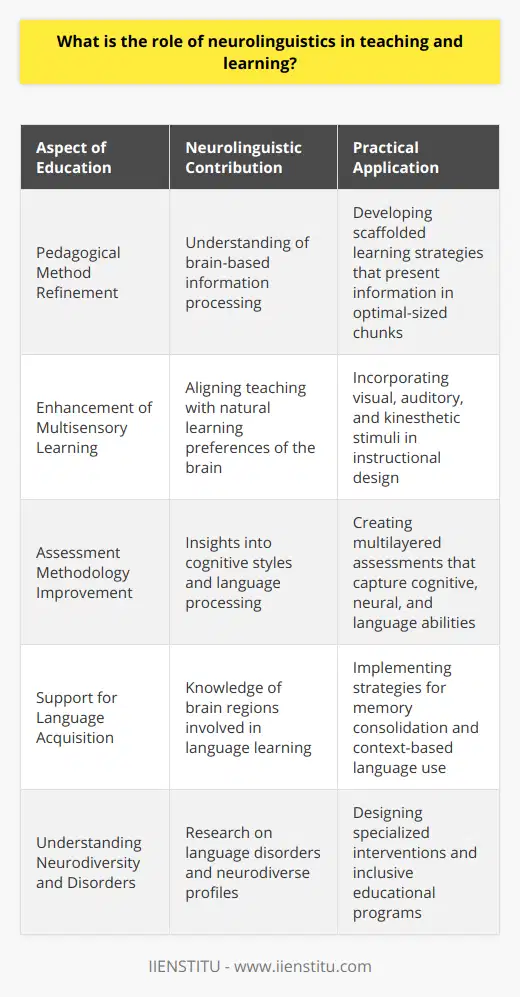
What is NLP in education?
Introduction to NLP in Education
Natural Language Processing (NLP) in education refers to the application of computational techniques to analyze, understand, and generate human language in a manner that is beneficial for educational settings. NLP provides an innovative approach to enhance teaching and learning experiences through various tools and techniques, mostly related to textual and spoken language.
NLP Techniques Utilized in Education
Some of the NLP techniques implemented in education include automated essay scoring, intelligent tutoring systems, and sentiment analysis. Automated essay scoring systems evaluate student-written essays by comparing them with a pre-defined set of criteria. These systems help teachers save time and provide students with instant feedback to improve their writing skills. Intelligent tutoring systems are personalized learning platforms that adjust to each student's learning pace, offer relevant content, and provide real-time feedback by analyzing their language input. Sentiment analysis, on the other hand, assists educators in understanding the emotions and opinions of students by examining their textual feedback, enabling teachers to create a more engaging and supportive learning environment.
Benefits of NLP in Education
NLP's integration into educational practices brings several benefits to both teachers and students. It offers personalized learning experiences that cater to individual needs, making the educational process more engaging and efficient. NLP also aids in the assessment of students' understanding and performance, providing immediate, data-driven feedback that guides future learning. Moreover, NLP tools help educators create more inclusive content by identifying biases or stereotypes in teaching materials and language, ensuring a more equitable learning atmosphere.
Challenges and Future Developments
Despite its advantages, NLP in education faces some challenges that require further research and development. Primarily, cultural and linguistic diversity among students may hinder the accuracy and efficiency of NLP tools as they rely on grammatical rules and vocabulary knowledge. Additionally, ethical concerns surrounding data privacy and intellectual property rights have emerged, necessitating more transparent NLP applications that conform to legal and ethical standards.
In conclusion, NLP offers significant potential in revolutionizing the education sector by providing personalized and efficient learning experiences, supporting assessment and feedback, and fostering a more inclusive environment. However, addressing the limitations and ethical concerns associated with NLP will be paramount to ensure its successful and responsible implementation in educational settings.
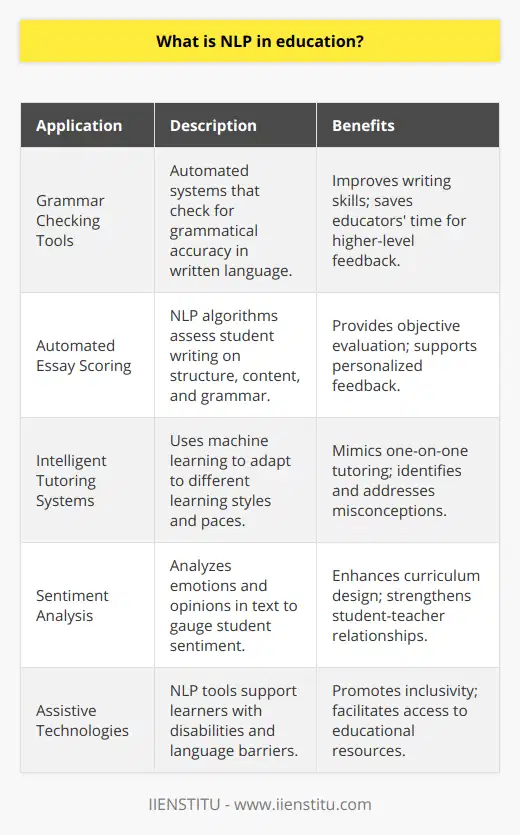
How is NLP useful for students in enhancing their learning experience?
Subheading: Personalized Learning Approach
Natural Language Processing (NLP) plays a vital role in enhancing students' learning experiences by personalizing the learning process. With NLP, educators can analyze students' textual input, allowing them to identify each student's learning style, strengths, and weaknesses. Consequently, this information aids in tailoring educational materials and teaching methods to suit individuals' needs better.
Subheading: Facilitating Feedback and Assessment
NLP has the potential to revolutionize the feedback and assessment process in education. It enables automatic evaluation of students' written responses, making it easier for educators to provide timely and meaningful feedback. Moreover, NLP-driven systems can compare students' work to predetermined criteria, ensuring consistency and fairness in grading. This quicker evaluation process allows students to identify gaps in their understanding and make adjustments accordingly.
Subheading: Enhancing Language Acquisition
For students learning new languages, NLP can be instrumental in identifying areas requiring improvement and providing targeted feedback. NLP-based applications, such as language learning apps and online translation tools, offer real-time analysis and correction mechanisms. These resources facilitate students' understanding of complex language structures, enabling them to develop and practice their communication skills more effectively.
Subheading: Fostering Collaboration and Communication
NLP technologies can improve collaboration and communication among students. Online discussion forums, for instance, rely on NLP algorithms to analyze and filter content, ensuring healthy, constructive conversations. Additionally, NLP can help identify and facilitate relationships between students with similar learning styles or educational goals, leading to more effective peer-to-peer collaborations.
Subheading: Accessibility for Diverse Learners
The use of NLP can significantly improve access to education for students with special needs, such as dyslexic individuals, deaf or hard-of-hearing students, and non-native speakers. For example, NLP-powered text-to-speech and speech-to-text applications can assist in delivering content tailored to the unique needs of these learners, offering a more inclusive educational experience.
In conclusion, NLP provides numerous benefits for enhancing the learning experience of students by enabling personalized learning, facilitating effective feedback and assessment, supporting language acquisition, fostering collaboration and communication, and improving accessibility for diverse learners. By integrating NLP technologies into educational systems, institutions can empower their students to reach their full potential and achieve success in their academic pursuits.
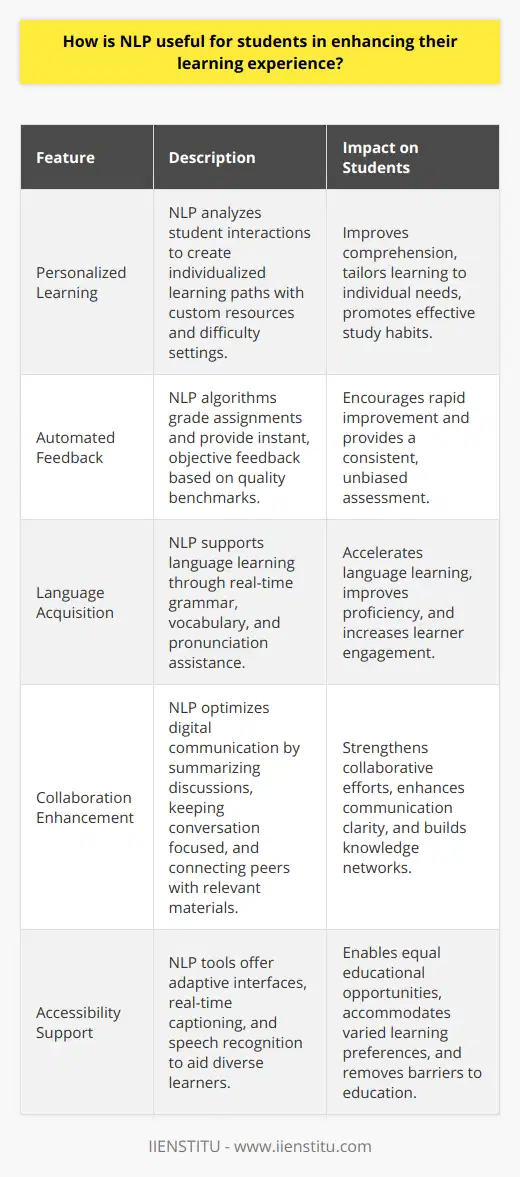
Can NLP help teachers in designing more effective and engaging lesson plans?
**NLP's Role in Lesson Planning**
Indeed, Natural Language Processing (NLP) can significantly contribute to helping teachers design more effective and engaging lesson plans. NLP, a subfield of Artificial Intelligence, focuses on enabling computers to understand, interpret, and generate human language. With advancements in this field, educators can harness NLP tools and techniques to enhance their instructional practices.
**Content Creation and Adaptation**
Firstly, NLP can aid in content creation and adaptation. By analyzing text from various sources, such as scholarly articles, textbooks, and web-based resources, NLP algorithms can summarize essential concepts and generate learning materials personalized to individual student needs. This customization ensures that lesson plans target specific learning objectives, engage diverse learners effectively, and foster a deeper understanding of the subject matter.
**Progress Monitoring and Feedback**
NLP-driven systems can enable teachers to monitor student progress continuously and provide automated, targeted feedback on their performance. These systems can identify potential gaps or misconceptions in students' understanding and suggest appropriate interventions. Consequently, NLP-enhanced lesson planning can be instrumental in designing engaging activities and formative assessments that help to bridge these gaps and clarify misunderstandings.
**Real-time Language Support**
For language teachers, NLP can facilitate real-time language support by evaluating students' language proficiency and detecting errors in their spoken or written output. These insights can help teachers address students' language difficulties, adjust lesson plans accordingly, and develop more focused language learning strategies. Additionally, by analyzing language patterns, NLP can also support teachers in selecting authentic and immersive language learning materials that cater to learners' interests and goals.
**Collaborative Learning**
Integrating NLP into teaching can promote collaborative learning by fostering peer interactions and teamwork. NLP-powered chatbots or virtual assistants, for instance, can act as discussion moderators or facilitators, guiding students to brainstorm, debate, and problem-solve together. By incorporating such interactive components into lesson plans, teachers can create a more dynamic and engaging learning environment.
In conclusion, NLP has enormous potential to revolutionize lesson planning in education. By harnessing NLP capabilities in content creation, progress monitoring, language support, and collaborative learning, teachers can design and deliver more effective, engaging, and personalized learning experiences for their students. As NLP technology continues to advance, its impact on teaching and learning is expected to grow even more significant in the coming years.
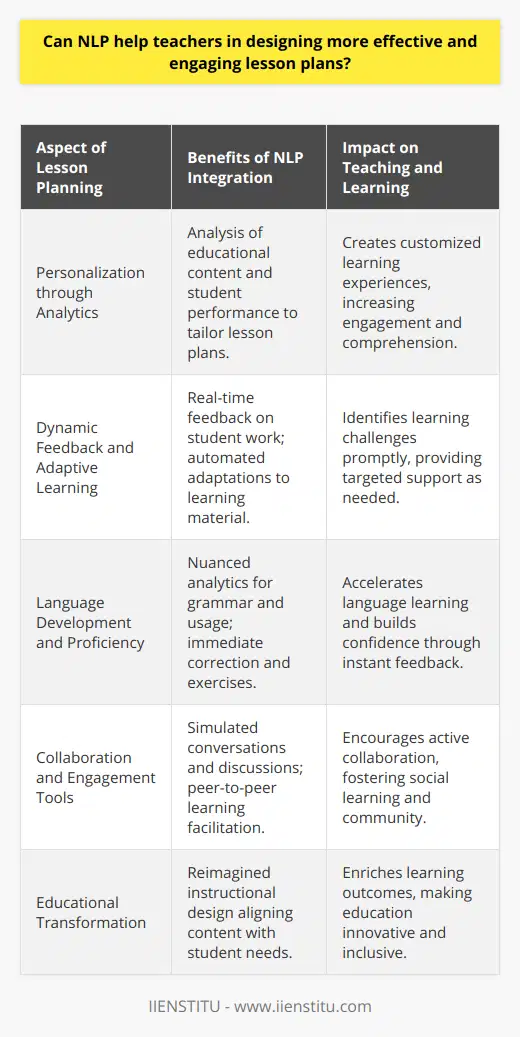
What is the role of NLP in fostering improved communication between students and teachers in the classroom?
Role of NLP in Classroom Communication
Enhancing Interaction between Students and Teachers
Natural language processing (NLP) plays a critical role in fostering effective communication between students and teachers in the classroom. By utilizing NLP algorithms, educational platforms can automatically analyze and interpret verbal and written communication. This analysis allows for a deeper understanding of individual communication patterns and enables teachers to identify areas where students may require additional support or clarification.
Facilitating Personalized Learning
In addition to supporting overall communication, NLP can also help teachers tailor their instruction to the individual learning needs. Through analyzing student-generated content, such as essays and homework assignments, NLP technology can identify patterns that indicate a student's strengths and weaknesses. Teachers can leverage this information to design more personalized lessons and assessments that target areas needing improvement.
Clarifying Feedback and Assessments
NLP can also be employed to develop clear and precise feedback on student work by analyzing linguistic structures and content quality. By providing targeted feedback, teachers can reduce confusion and misinterpretation, promoting more effective self-assessment and improvement. Furthermore, NLP can streamline the grading process by automating some aspects, such as identifying grammatical errors or measuring coherence, which allows educators to dedicate more time to personalized teaching.
Promoting Language Proficiency
Language acquisition is a core area where NLP can facilitate improved learning outcomes for students, particularly within the context of second-language learning. NLP tools can analyze a student's written or spoken inputs and provide real-time assistance with pronunciation, grammar, and syntax. This instant feedback helps students refine their language skills and develop confidence in their ability to communicate effectively.
Creating Inclusive Learning Environments
Finally, NLP supports inclusive learning environments by identifying and addressing potential biases in instructional materials and classroom communication. Tools that detect biased language or harmful stereotypes play a critical role in fostering a culture of equity and belonging, which ultimately contributes to improved communication between students and teachers.
In conclusion, the role of NLP in classroom communication is multifaceted, encompassing enhanced interaction, personalized learning, clear assessments, language proficiency, and inclusive learning environments. By integrating NLP technology into the instructional process, educators can become better communicators and promote more effective learning outcomes for students.
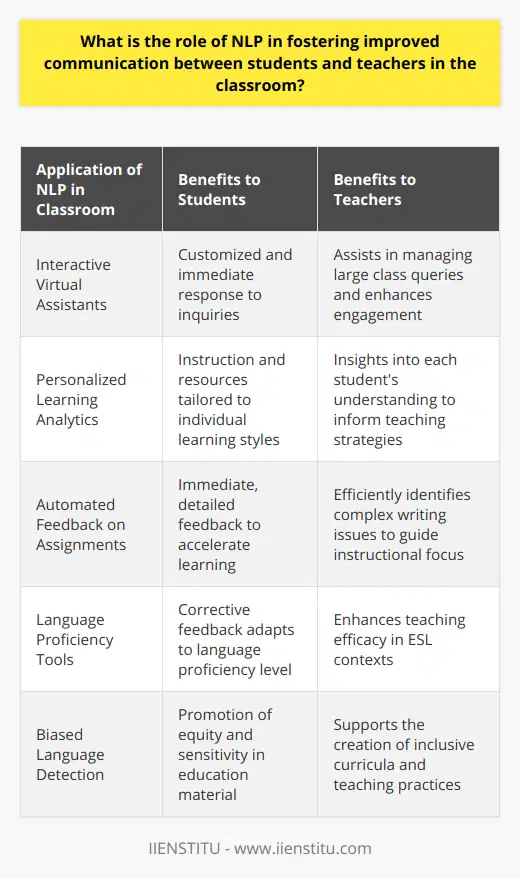
Can NLP help with learning and overcoming language barriers in multilingual classrooms?
NLP and Language Learning
Natural Language Processing (NLP) has transformative capabilities in learning and overcoming language barriers in multilingual classrooms. Significant changes occur in teaching methodologies with this AI-powered tool.
Enhanced Vocabulary Building
NLP offers interactive platforms that stimulate vocabulary building. It tracks learner's progress and suggests words and phrases relevant to their proficiency level. Vocabulary, being a critical element in language acquisition, consequently improves.
Intelligent Grammar Assistance
Beyond vocabulary, NLP offers intelligent grammar correction. AI recognizes common grammatical errors and helps rectify them. Students learn correct language usage without needing one-on-one instructor correction or intervention.
Fluency and Pronunciation
NLP algorithms also facilitate fluency and pronunciation improvement. Speech-recognition features offer real-time feedback and correction on speech patterns. This focused practice results in noticeable pronunciation improvements.
Quick Translation Services
To aid understanding, NLP offers swift translation services. It helps decode languages, advancing comprehension in multilingual classrooms. Students get immediate sentence translation, making language learning easier.
Cultural Sensitivity
Lastly, NLP considers cultural sensitivities. It incorporates regional dialects and idioms relevant to the learners' backgrounds. Such cognitive approach enriches learning experiences in multilingual settings.
In conclusion, NLP can indeed assist in overcoming language barriers in multilingual classrooms. It serves as a beneficial tool in promoting effective language learning, ensuring efficient communication, and fostering cultural sensitivity.

What is the role of neurolinguistics in enhancing personalized learning experiences for students?
Understanding Neurolinguistics in Personalized Learning
Neurolinguistics studies the brain mechanisms behind language comprehension and production. To enhance personalized learning experiences, neurolinguistics plays a crucial role.
Role in Language Learning
This interdisciplinary field reveals how the brain processes language. Understanding these processes can aid in creating efficient and effective learning strategies tailored to individual learners. Underlying neurological mechanisms decoded by neurolinguistics can provide crucial insights into varied language learning abilities and style preferences among learners.
Neurolinguistics and Learning Styles
Different learners have unique ways of integrating and retaining new information. Neurolinguistics helps us identify these distinct learning styles. By pinpointing particular brain functions linked to language learning, educators can build personalized learning plans that acknowledge each student’s strengths.
Enhancing Personalized Education
Neurolinguistics contributes significantly to personalized education by pointing out neural pathways associated with language learning. It provides a roadmap for building learning experiences that match individual neuronal activities and learning capabilities.
Neurolinguistics and Learning Disorders
Finally, neurolinguistics can be instrumental in identifying and managing learning disorders. By studying the typical brain function patterns, educators can determine when a student’s brain exhibits atypical behavior. This understanding can enhance personalized interventions and support for students with learning difficulties.
In conclusion, neurolinguistics holds immense importance in creating effective personalized learning experiences. By offering insights into brain function, neurological diversity, and learning styles, it helps adapt teaching strategies to individual learners, thus enhancing the overall educational experience.

How can NLP contribute to the development of more inclusive teaching methods in diverse academic settings?
Advancements in Natural Language Processing (NLP)
Natural Language Processing (NLP) can directly influence the development of more inclusive teaching methodologies in versatile academic settings. This technology can reshape the educational landscape by addressing learning needs with personalized content.
Utilizing NLP for Learner Diversity
NLP empowers educators to validate the learning environment for our changing student population. It accommodates different cultures, languages, cognitive abilities, and learning styles. NLP technology can break down language barriers and assist those with learning disabilities or non-native English speakers.
Assisting Unique Learning Styles
NLP incorporates adaptive learning to support individual learning styles. It enables the development of personalized learning paths, enhancing lesson effectiveness. This customization fosters better engagement and greater knowledge retention among diverse learners.
Promoting Accessibility in Education
Above all, NLP enhances the accessibility of learning materials. It transforms text to speech, aiding visually impaired students. Additionally, it translates text into multiple languages, fostering linguistic inclusivity.
Bridging the Communication Gap
NLP tools can offer real-time translation services, bridging the communication gap between teachers and learners from different linguistic backgrounds. It diminishes misunderstandings arising from language disparities, fostering a more inclusive class atmosphere.
Monitoring Student Progress
The capabilities of NLP extend to monitoring student progress accurately. NLP-based tools provide insights into students' comprehension levels, aiding teachers to adjust their instruction accordingly. They also help identify areas where students are struggling, enabling more targeted intervention strategies.
NLP: A Tool for Inclusive Education
To sum up, NLP can contribute significantly to creating inclusive teaching methods in diverse academic environments. Its capacity to adapt to individual learning needs and bridge language barriers fosters a more inclusive educational environment. Moreover, its ability to monitor student progress allows educators to tailor their teaching strategies effectively and promptly. Therefore, adopting NLP in educational settings is a major stride towards accessible and inclusive education.



